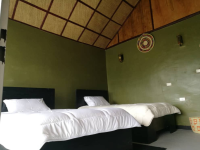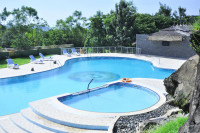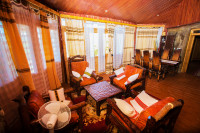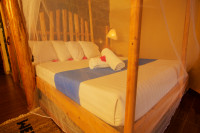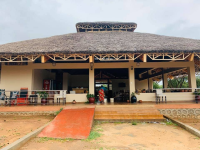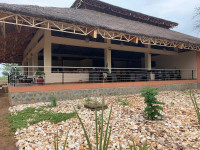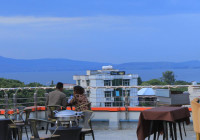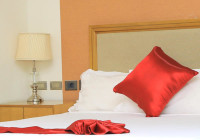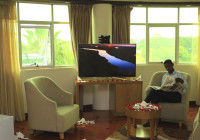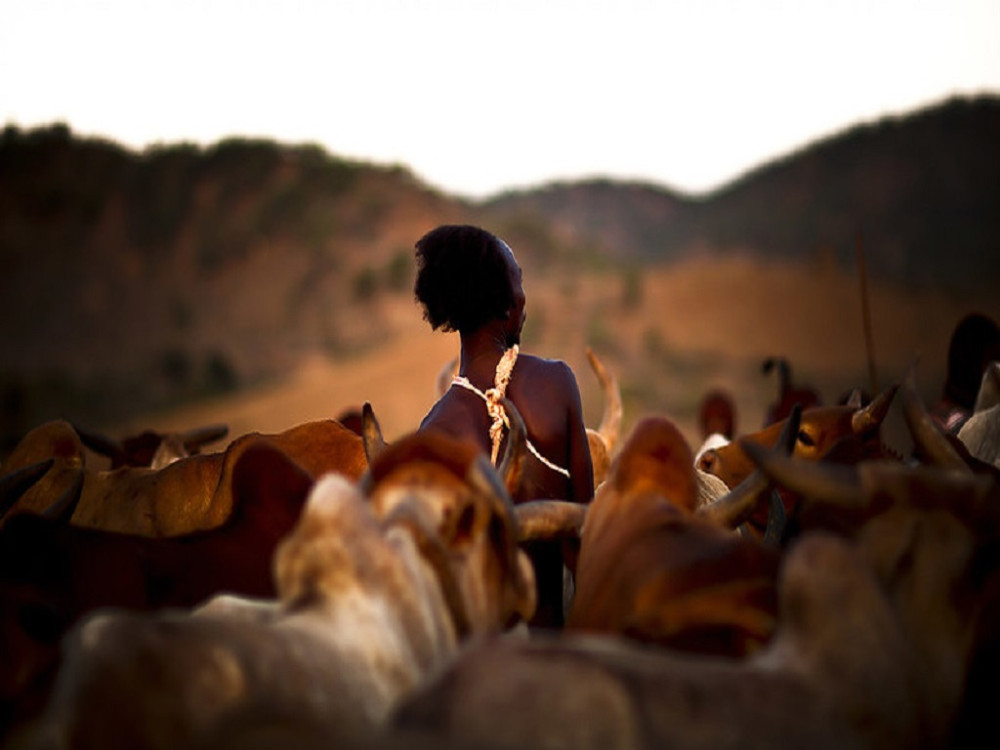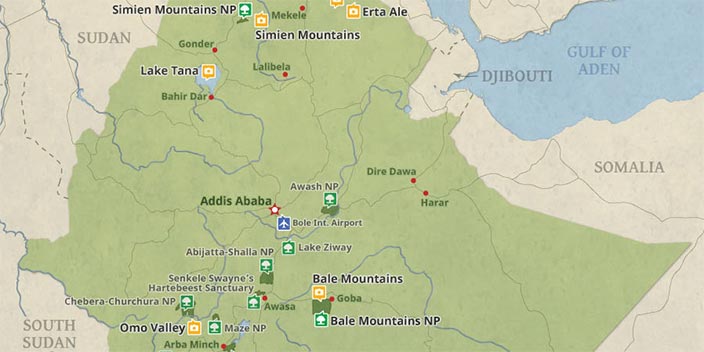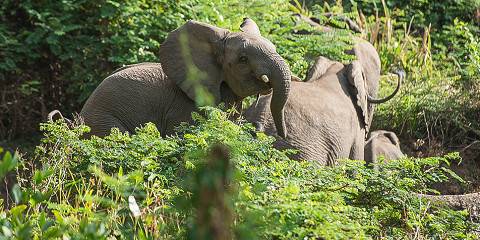
$2,094 pp (USD)
This tour is offered in EUR.
Show rate in EUR
Arrival
Arrival

Day 1
Arrival, Fly to Jimma and Drive to Chebera
Arrival, Fly to Jimma and Drive to Chebera
This Authentic Ethiopia Safari starts in Addis Ababa, the vibrant capital of Ethiopia. We will pick you up from your home and to the airport, you are transferred to for domestic flight to Jimma. When arrive at Jimma you will directly drive southwest to Chebera Churchura National Park in the highlands. We arrive at Chebera Churchura National Park and embark on the first game drive of our Ethiopia Safari. This beautiful, untouched wilderness area is home to elephants, buffalos, hippos and other mammals, along with over 235 bird species.
- Main Destination:
- Chebera-Churchura National Park
- Accommodation:
- Chebera Safari Lodge
- Meals & Drinks:

Day 2
Visit Cheber Churchura National Park
Visit Cheber Churchura National Park
Spend the whole of day exploring the untouched Chebera Churchura National Park. Our exploration takes us through the various habitats of Chebera Churchura, from wooded grasslands to riverine forests. This is a relatively new national park declared in 2005 primarily to create habitat for declining elephant populations.
Today the park is known for its large elephant population, serving as a stronghold for Ethiopian elephants, as well as hosting impressive numbers of buffalos. Chebera Churchura is also home to lions, hyenas, hippos, leopards and other large mammals so keep your eyes peeled on our game drives. The park features numerous streams, rivers and small lakes supporting healthy populations of animals and birds year-round. Endemic bird species include white-winged cliff chat, banded-barbet, wattled ibis, black-headed forest oriole and thick-billed raven.
- Main Destination:
- Chebera-Churchura National Park
- Accommodation:
- Chebera Safari Lodge
- Meals & Drinks:

Day 3
Drive to Arbaminch
Drive to Arbaminch
Day four of our Ethiopia Safari kicks off with an early morning game drive in Chebera Churchura Park - an ideal time to spot mammals and birds in the African bush. After our final game drive in the crowd-free Chebera Churchura, we head southeast to Maze National Park. Maze National Park is one of only three protected areas that still hosts good populations of the critically endangered Swayne's Hartebeest, endemic to Ethiopia. This 210 km² national park is home to about 39 mammal species and 196 bird species, encompassing savannah grasslands dotted with broad-leaved deciduous trees and riverine bush along the rivers. Other wild animals found in Maze include leopards, wild cats, baboons, monkeys and various antelope species such as Oribi, Kudu and Waterbuck. Drive to Arbaminch for overnight stay.
- Main Destination:
- Arba Minch (City)
- Accommodation:
- Paradise Lodge
- Meals & Drinks:

Day 4
Drive to Turmi
Drive to Turmi
After breakfast, you will continue your drive Turmi. You will stop to visit the Konso tribe with their king- UNESCO registered site for their extensive terracing and practice of making a wooden grave mark for their hero and kings. Differing from their neighbors, the Konso are pure agriculturists, famed for their use of the stone terraces. A generation pole classifies the age of each town and each family lives in compounds that are accessible only through gateways that require the visitor to enter on all fours thereby rendering any potential attackers vulnerable.
After lunch, we drive to Turmi and on the way appreciate the very attractive culture of the landscape of the rift valley. You will stop and visit Key Afer Market. 0nce a week, a small town of Key Afer in the Lower Omo Valley holds a large market (the largest in Omo Valley) where three different tribes come together to buy and sell. Continue driving and arrive late afternoon to Turmi.
- Main Destination:
- Turmi (Lower Omo Valley)
- Accommodation:
- Paradise Lodge
- Meals & Drinks:

Day 5
Visit Turmi Area Tribes
Visit Turmi Area Tribes
After early breakfast, we continue through the savannah along tracks that are barely visible, passing through a vast meadowland with shrubs and umbellifers (‘umbrella’ acacia trees) for an excursion to Kangatan Village. This tribe is also known as Nyangatom. The Nyangatom live south of Omo National Park and occasionally migrate in to the lower regions of the park when water or grazing is scarce. After the visit, return across the river and proceed to the Karo village of Korcho, with a stunning location look in over the Omo River. The Karo people, while the smallest tribe of the Omo Valley in number, are also known to be the most decorated. After lunch, we start driving south to Omorate to visit another tribe, the Dasenech and one of their villages. Originally nomadic pastoralists, the more fertile surroundings of the Omo River have caused them to put down more permanent roots based around fishing and agriculture. Women wear a pleated cow skin skirt with necklaces and bracelets.

Day 6
Visit Erbore Tribe and Drive back to Arbaminch
Visit Erbore Tribe and Drive back to Arbaminch
After breakfast, we drive back to Aribaminch via woita road on the way visiting the Erbore people. Relatively large, Arbore is far more rustic and unaffected than many similarly size towns in south Omo, in common with their linguistically and culturally affiliated Tsemai neighbors, the Arbore migrated to their present homeland from Konso perhaps two centuries ago. Because they have ancestral and cultural links to Konso and the pastoralists of the surrounding lowlands, the Arbore traditionally played an important role as intermediaries in trade between the Omo River and the Konso Highlands. The town of Arbore lies in an area where several tribal boundaries coverage. In addition, the Arbore people routinely intermarry with other ethnic groups. It is also inhabited a substantial number of Hamer and even Borena women – adding a cosmopolitan feel to the worthwhile Saturday market. After visiting, you will drive to Konso and have lunch and drive to Arbaminch for overnight stay.
- Main Destination:
- Arba Minch (City)
- Accommodation:
- Paradise Lodge
- Meals & Drinks:

Day 7
Drive to Hawassa
Drive to Hawassa
After breakfast this morning, we will commence another long yet scenic drive to Hawassa via Wolatya Sodo. En route you will potentially visiting the interesting Alaba and Wolata villages. You will pass through the fertile land of Wolayta with their fascinating culture and the false Banana preparation and coffee plantations and Alaba regions. You will pass through land, which produces the best banana, papaya, apple and mango in Ethiopia for the world market. The Alaba people are very famous for their beautiful home painting style. After lunch, drive to privet farm spend the day surrounded by coffee plantations that produce Sidama coffee, one of the three coffee brands of the well-known Arabica coffee.
- Main Destination:
- Awasa (City)
- Accommodation:
- Heron Hotel
- Meals & Drinks:

Day 8
Drive to Addis Ababa and Departure
Drive to Addis Ababa and Departure
On this day we leave Hawassa, Visit “Amora Gedel”-the daily fishing market on the shore of Lake Hawassa and get really close to pelicans, storks and other birds very much used to human company. Here, many vendors hawked fish by the water. In addition, others set up stalls offering fish stew and chili spices by the entrance. On the way, we visit Abijata and Shall National Park. Then, we drive to Ziway Town and have lunch stop. After lunch, we directly drive to Addis Ababa. Early in the afternoon, we arrive in Addis Ababa and have time for souvenir shop anything you want to do before departure.
In the evening, farewell party dinner invitation by Finot Tour Ethiopia with cultural dinner and traditional special dinner and local drinks to experience Ethiopia’s cultural meals and drinks. Here you will enjoy and experience several tribal dances. After farewell dinner party, we transfer you to Bole International Airport for international departure.
- Main Destination:
- Addis Ababa (City)
- Accommodation:
- No accommodation (End of tour)
- Meals & Drinks:


